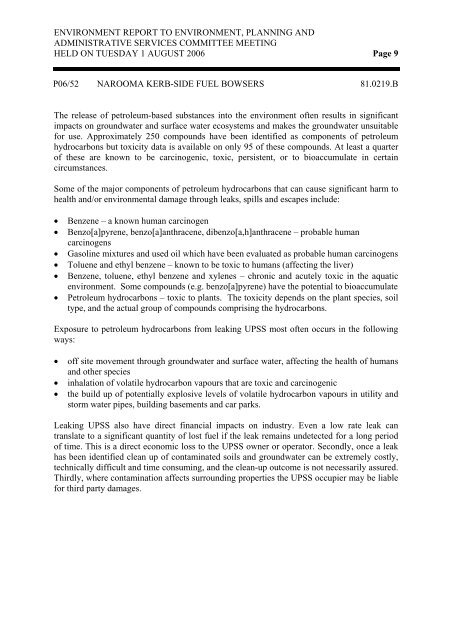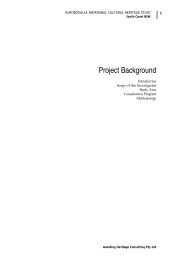Planning Agenda - Eurobodalla Shire Council - NSW Government
Planning Agenda - Eurobodalla Shire Council - NSW Government
Planning Agenda - Eurobodalla Shire Council - NSW Government
You also want an ePaper? Increase the reach of your titles
YUMPU automatically turns print PDFs into web optimized ePapers that Google loves.
ENVIRONMENT REPORT TO ENVIRONMENT, PLANNING AND<br />
ADMINISTRATIVE SERVICES COMMITTEE MEETING<br />
HELD ON TUESDAY 1 AUGUST 2006 Page 9<br />
P06/52 NAROOMA KERB-SIDE FUEL BOWSERS 81.0219.B<br />
The release of petroleum-based substances into the environment often results in significant<br />
impacts on groundwater and surface water ecosystems and makes the groundwater unsuitable<br />
for use. Approximately 250 compounds have been identified as components of petroleum<br />
hydrocarbons but toxicity data is available on only 95 of these compounds. At least a quarter<br />
of these are known to be carcinogenic, toxic, persistent, or to bioaccumulate in certain<br />
circumstances.<br />
Some of the major components of petroleum hydrocarbons that can cause significant harm to<br />
health and/or environmental damage through leaks, spills and escapes include:<br />
• Benzene – a known human carcinogen<br />
• Benzo[a]pyrene, benzo[a]anthracene, dibenzo[a,h]anthracene – probable human<br />
carcinogens<br />
• Gasoline mixtures and used oil which have been evaluated as probable human carcinogens<br />
• Toluene and ethyl benzene – known to be toxic to humans (affecting the liver)<br />
• Benzene, toluene, ethyl benzene and xylenes – chronic and acutely toxic in the aquatic<br />
environment. Some compounds (e.g. benzo[a]pyrene) have the potential to bioaccumulate<br />
• Petroleum hydrocarbons – toxic to plants. The toxicity depends on the plant species, soil<br />
type, and the actual group of compounds comprising the hydrocarbons.<br />
Exposure to petroleum hydrocarbons from leaking UPSS most often occurs in the following<br />
ways:<br />
• off site movement through groundwater and surface water, affecting the health of humans<br />
and other species<br />
• inhalation of volatile hydrocarbon vapours that are toxic and carcinogenic<br />
• the build up of potentially explosive levels of volatile hydrocarbon vapours in utility and<br />
storm water pipes, building basements and car parks.<br />
Leaking UPSS also have direct financial impacts on industry. Even a low rate leak can<br />
translate to a significant quantity of lost fuel if the leak remains undetected for a long period<br />
of time. This is a direct economic loss to the UPSS owner or operator. Secondly, once a leak<br />
has been identified clean up of contaminated soils and groundwater can be extremely costly,<br />
technically difficult and time consuming, and the clean-up outcome is not necessarily assured.<br />
Thirdly, where contamination affects surrounding properties the UPSS occupier may be liable<br />
for third party damages.
















